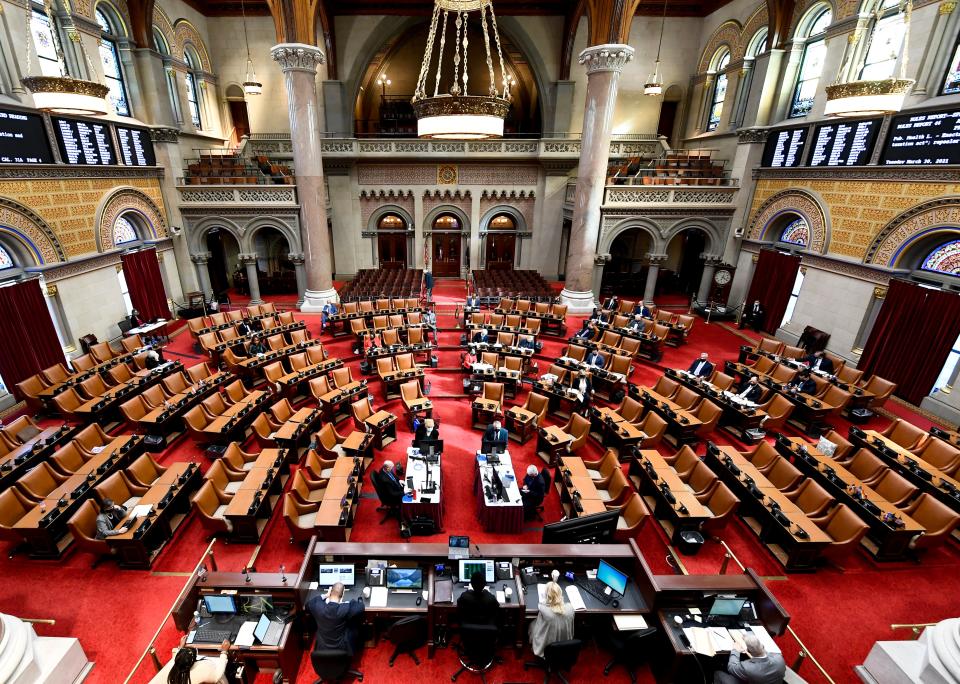Can America work without a robust free press? Journalism needs a bailout | Opinion
Rob Gavin grew up on Staten Island in New York City, studied journalism at a public college, then got his dream job in 1997 — as a reporter with his hometown daily newspaper, the Staten Island Advance. In 2000, more magic happened.
Gavin was asked to be the newspaper’s Albany correspondent in the state capitol, covering one of the most important legislatures in the nation for six years. His home was the press room, where a huge tribe of reporters fought over desks, mingled with PR people, and muscled to get access to powerful politicians.
A horde of reporters and the smell of newsprint filled the room — a journalism mob scene. The AP had four reporters, Gannett three, the NY Daily News two, and many of the state’s dailies sent correspondent to watch their local legislators. It was a glorious time, still, for print media.
And then that news world crumbled.
By the time Gavin left in 2005 to join the Albany Times Union, “The number of reporters was down drastically. It really decreased,” Gavin told me. His newspaper sent one more correspondent to cover the capitol, then stopped, as did dozens of others.

As the more efficient internet surveillance environment gobbled up advertisers, publications declined. Between 2004 and 2020, 71 daily and 2,196 weekly publications closed. Since 2008, the U.S. lost 40,000 local journalists.
Scholars studying this issue refer to “news deserts,” entire cities and villages without a viable news outlet. Other publications survive, of course, but many have been devastated. Where I live in New York’s Hudson Valley, small quality publications have lost almost their entire news staffs to cutbacks. They are shadows of their former feisty watchdog selves.
“The information crisis facing America,” says author and scholar Robert McChesney, “is not the emergence and dominance of propaganda, baseless claims, and cynical conspiracy theorizing. This tsunami of misinformation results from the much larger problem — the collapse of local journalism.”
McChesney, an esteemed professor, has studied the American press for decades, and is worried, as are many of us. Unless this collapse “is addressed directly and successfully, it is impossible to see how the threat of a more authoritarian, even fascistic, future can be subdued.”
For the first time in his life, observes McChesney, who is 70, “very smart people are debating whether functional democracy and the rule of law can even survive.” But McChesney is doing more than carping about the future.
He is championing the Local Journalism Initiative, which mimics legislation that’s part of President Biden’s $1.9 trillion Build Back America proposal, now languishing in Congress. That proposal would strengthen child care tax credits, rebuild roads, bridges and waters systems, create electric energy options, and improve internet accessibility.

But it would also provide $34 billion for an independent and competitive local news media. McChesney calls it “human labor competing and working together to cover communities and produce news.” Taxpayers would subsidize the press in the same way we do schools and libraries, other bulwarks of democracy.
Censorship: We should worry about social media censorship — truth can always prevail | Rob Miraldi
Free speech: We must make the First Amendment 'durable.' Here's why | Rob Miraldi
As I see it, one antidote for our current divisiveness is a local press that pulls neighbors together, tells us about births, deaths, marriages; about the city councils, school boards, courts — the essence of civic life. But one that also lets us know who made the Honor Roll or grew the largest pumpkin.
It is the only viable option, McChesney concludes, “when the market has showed that it cannot begin to sustain existing media, let alone usher in a renewal of bold speak-truth-to-power journalism.”
Citizens, already reluctant to spend money, will face “sticker shock.” Too much money.
The correct response, counters McChesney, “the one that guided our Founders, is what will the cost be if we don’t do it? We can see signs all around us of what that looks like. We can no more lowball having a credible press as our democracy crumbles than we would lowball military spending in the midst of a foreign invasion.”
Oh, by the way, the defense budget this year is $768.2 billion; we gave $400 million to Ukraine in 2021. And yet I haven’t seen any Russian ships coming up the Hudson River but I have seen collapsing newsrooms. And thousands of people believing total lies.
Here’s how it would work? Money would be allotted to counties based on population. A county of 250,000 people gets $25 million to produce local journalism. The publications must be non-profit. But profit-making publications could apply for six years as they attempt to see if the new approach makes ends meet better — and improves the news product.
The goal: “stop the bleeding in for-profit newsrooms, even as we build a necessary and more viable noncommercial system,” says McChesney.
“This nation has been praying for the market to magically solve the collapse of journalism for two decades and look where we are and where we are heading,” McChesney says. “The evidence is in. The time to act is now.”
Who would administer a huge new system to choose local publications? The U.S. Postal System — a logical choice. In the 19th century the Post Office subsidized the American press for many years, before advertising. Consequently, America had far more newspapers than any other country. The Post Office would return “as a guardian of free press. It has a wonderful track record of being neutral.”
McChesney points out that the Framers were obsessed with making certain a vibrant press developed in the new United States. This “did not simply mean the government would reject censorship. It meant the government had the fundamental obligation to see that journalism actually existed, that there was something the government could not censor.”
The proposal will face many hurdles. Will the public be willing to pay?
“We bail out banks and build new missiles. Why not?” asks McChesney.
Of course, the answer to that might be that people are suspicious of government funding much of anything, let alone an institution that is despised by the MAGA right.
Won’t the public say there is plenty of news available?
“Not if they actually look at what is news … at how little original reporting by human beings is taking place,” counters McChesney. “We see a blizzard of crap. Very little actual journalism.”
And while, in part, I agree with McChesney, there is still a lot of good reporting out there — some of it coming from hyper-local web sites that would benefit greatly from this new money.
The biggest hurdle might simply be that powerful interests won’t want a stronger-than-ever watchdog press. It’s tougher to hide your misdeeds and spread lies when the press is sniffing around.
“Entrenched power often is the target of a robust press,” McChesney concedes.
So, the question is: Will the people understand that a self-governing society cannot work without a flourishing press, on both local and national levels?
“We are in a moment of either birth or death, a critical juncture. We need a real solution, not just a Band-Aid. The Constitutional system,” McChesney warns, “might not survive this decade.”
Rob Miraldi’s writings on the First Amendment have won numerous state and national awards. He teaches journalism at SUNY Paltz.
Twitter @miral98
Email: miral98@aol.com
This article originally appeared on Poughkeepsie Journal: American journalism needs a bailout

